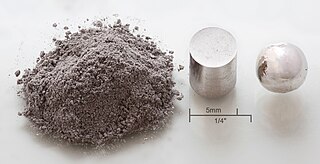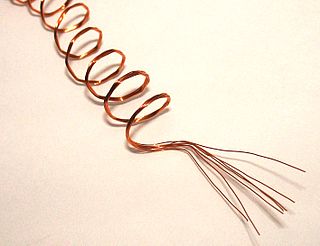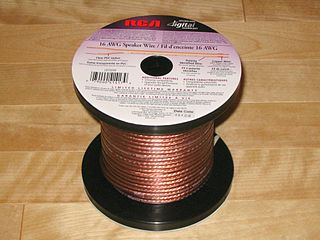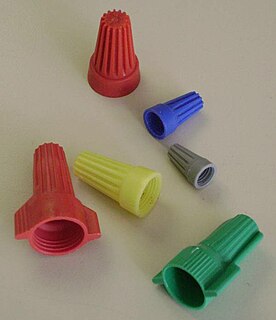
Palladium is a chemical element with symbol Pd and atomic number 46. It is a rare and lustrous silvery-white metal discovered in 1803 by William Hyde Wollaston. He named it after the asteroid Pallas, which was itself named after the epithet of the Greek goddess Athena, acquired by her when she slew Pallas. Palladium, platinum, rhodium, ruthenium, iridium and osmium form a group of elements referred to as the platinum group metals (PGMs). These have similar chemical properties, but palladium has the lowest melting point and is the least dense of them.

Rhodium is a chemical element with symbol Rh and atomic number 45. It is a rare, silvery-white, hard, corrosion-resistant, and chemically inert transition metal. It is a noble metal and a member of the platinum group. It has only one naturally occurring isotope, 103Rh. Naturally occurring rhodium is usually found as the free metal, alloyed with similar metals, and rarely as a chemical compound in minerals such as bowieite and rhodplumsite. It is one of the rarest and most valuable precious metals.
American wire gauge (AWG), also known as the Brown & Sharpe wire gauge, is a logarithmic stepped standardized wire gauge system used since 1857, predominantly in North America, for the diameters of round, solid, nonferrous, electrically conducting wire. Dimensions of the wires are given in ASTM standard B 258. The cross-sectional area of each gauge is an important factor for determining its current-carrying ampacity.

A banana connector is a single-wire electrical connector used for joining wires to equipment. The term 4 mm connector is also used, especially in Europe, although not all banana connectors will mate with 4 mm parts, and 2 mm banana connectors exist. Various styles of banana plug contacts exist, all based on the concept of spring metal applying outward force into the unsprung cylindrical jack to produce a snug fit with good electrical conductivity. Common types include: a solid pin split lengthwise and splayed slightly, a tip of four leaf springs, a cylinder with a single leaf spring on one side, a bundle of stiff wire, a central pin surrounded by a multiply-slit cylinder with a central bulge, or simple sheet spring metal rolled into a nearly complete cylinder. The plugs are frequently used to terminate patch cords for electronic test equipment, while sheathed banana plugs are common on multimeter probe leads.
Resistance thermometers, also called resistance temperature detectors (RTDs), are sensors used to measure temperature. Many RTD elements consist of a length of fine wire wrapped around a ceramic or glass core but other constructions are also used. The RTD wire is a pure material, typically platinum, nickel, or copper. The material has an accurate resistance/temperature relationship which is used to provide an indication of temperature. As RTD elements are fragile, they are often housed in protective probes.

Berg connector is a brand of electrical connector used in computer hardware. Berg connectors are manufactured by Berg Electronics Corporation of St. Louis, Missouri, a division of Framatome Connectors International.

Litz wire is a type of specialized multistrand wire or cable used in electronics to carry alternating current (AC) at radio frequencies. The wire is designed to reduce the skin effect and proximity effect losses in conductors used at frequencies up to about 1 MHz. It consists of many thin wire strands, individually insulated and twisted or woven together, following one of several carefully prescribed patterns often involving several levels. The result of these winding patterns is to equalize the proportion of the overall length over which each strand is at the outside of the conductor. This has the effect of distributing the current equally among the wire strands, reducing the resistance. Litz wire is used in high Q inductors for radio transmitters and receivers operating at low frequencies, induction heating equipment and switching power supplies.

Speaker wire is used to make the electrical connection between loudspeakers and audio amplifiers. Modern speaker wire consists of two or more electrical conductors individually insulated by plastic or, less commonly, rubber. The two wires are electrically identical, but are marked to identify the correct audio signal polarity. Most commonly, speaker wire comes in the form of zip cord.

Twist-on wire connectors are a type of electrical connector used to fasten two or more low-voltage electrical conductors. They are widely used in North America in residential, commercial and industrial building power wiring.

Wire gauge is a measurement of wire diameter. This determines the amount of electric current a wire can safely carry, as well as its electrical resistance and weight.

A circular mil is a unit of area, equal to the area of a circle with a diameter of one mil. It corresponds to 5.067×10−4 mm2. It is a unit intended for referring to the area of a wire with a circular cross section. As the area in circular mils can be calculated without reference to π, the unit makes conversion between cross section and diameter of a wire considerably easier.

A binding post is a connector commonly used on electronic test equipment to terminate (attach) a single wire or test lead. They are also found on loudspeakers and audio amplifiers as well as other electrical equipment.
A jewelry wire is wire, usually copper, brass, nickel, aluminium, silver, or gold, used in jewelry making.

British Standard Wire Gauge is a set of wire sizes given by BS 3737:1964, and is generally abbreviated to SWG. It is also known as: Imperial Wire Gauge or British Standard Gauge. Use of SWG sizes has fallen greatly in popularity, but is still used as a measure of thickness in guitar strings and some electrical wire. Cross sectional area in square millimetres is now the more usual size measurement for wires used in electrical installation cables. The current British Standard for metallic materials such as wire and sheet is BS 6722:1986, which is a solely metric standard.

Copper tubing is most often used for the supply of hot and cold tap water, and as a refrigerant line in HVAC systems. There are two basic types of copper tubing, soft copper and rigid copper. Copper tubing is joined using flare connection, compression connection, or solder. Copper offers a high level of corrosion resistance but is becoming very costly.
Body jewelry sizes express the thickness of an item of body jewelry, using one of several possible systems.

FASTON terminals are connectors, widely used in electronic and electrical equipment. These terminals are manufactured by many different vendors, commonly using the term "quick disconnect", "tab" terminals, or blade connectors. They are similar in size to some of the Packard terminals, such as Packard 56, and may have been derived from them.


















